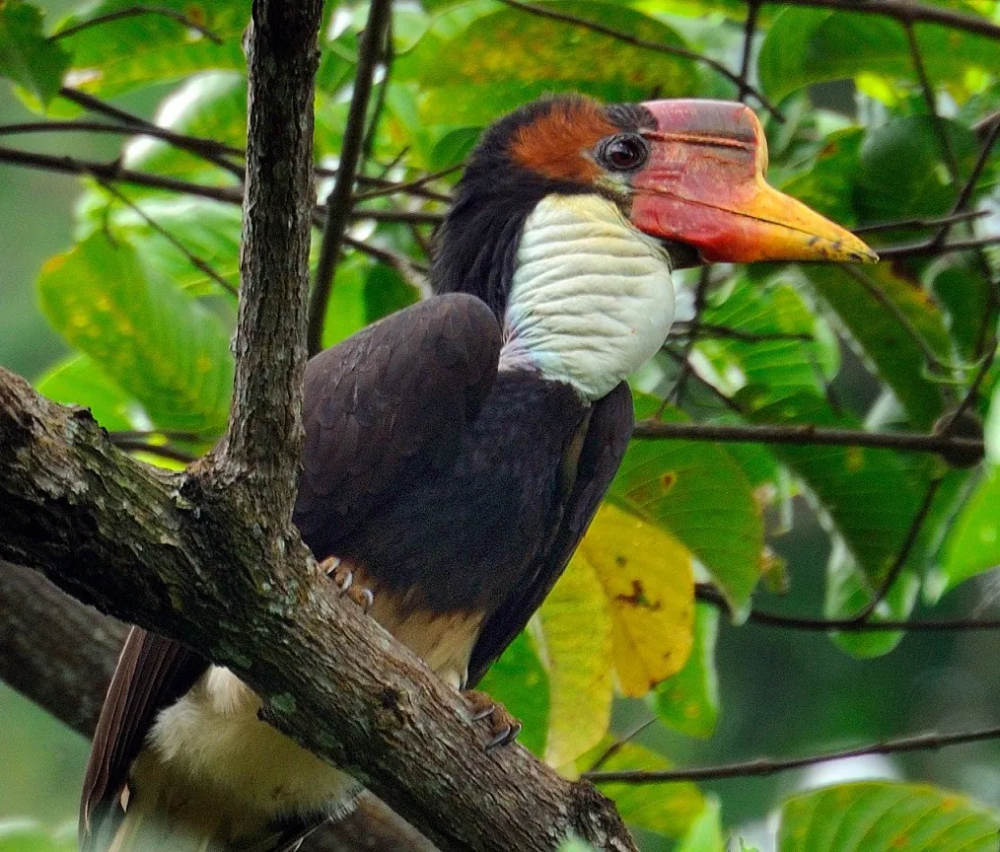In the dense rainforests of Southeast Asia, a remarkable creature with a distinctive appearance and a haunting call roams the canopy. The (Rhinoplax vigil), with its striking casque and unique habits, is an iconic bird species that symbolizes the biodiversity and splendor of the region’s forests. However, this magnificent bird is facing a severe threat to its survival due to habitat loss, poaching, and illegal trade. In this article, we delve into the fascinating world of the Helmeted Hornbill, exploring its biology, behavior, cultural significance, and the urgent need for conservation efforts to safeguard its future.
Anatomy and Appearance of Helmeted Hornbill
One of the most striking features of the Helmeted Hornbill is its large, solid casque, which adorns the top of its bill. This casque, composed of keratin (the same material found in human fingernails), is unique among hornbills and gives the bird its distinctive appearance. The casque is often brightly colored, ranging from pale yellow to deep red, and plays a crucial role in both courtship displays and territorial defense.
Apart from its remarkable casque, the Helmeted Hornbill has a predominantly black plumage, with white feathers on its tail and wingtips. Its sizable bill, adorned with a casque, is another prominent feature, used primarily for feeding and communication. In flight, the bird’s large wings and long tail feathers are a sight to behold as it navigates the dense forest canopy with agility and grace.

Habitat and Distribution
The Helmeted Hornbill is endemic to the rainforests of Southeast Asia, where it inhabits mature, lowland forests and occasionally ventures into montane forests. Its range spans across countries such as Indonesia, Malaysia, Thailand, and Myanmar. Within these regions, the bird relies on the abundance of large trees for nesting, roosting, and foraging.
These forests provide not only a habitat for the Helmeted Hornbill but also a rich tapestry of biodiversity, supporting countless plant and animal species. However, rampant deforestation, driven by logging, agriculture, and infrastructure development, has led to the fragmentation and degradation of the bird’s habitat, pushing it closer to the brink of extinction.
Behavior and Ecology
Helmeted Hornbills are primarily frugivorous, feeding on a diet of figs and other fruits found in the forest canopy. They play a vital role in seed dispersal, helping to maintain the health and diversity of the forest ecosystem. In addition to fruits, they also consume insects, small reptiles, and occasionally small mammals, supplementing their diet with protein-rich prey.
Breeding season for Helmeted Hornbills typically occurs between February and June, during which time pairs engage in elaborate courtship displays. These displays often involve aerial acrobatics, vocalizations, and the exchange of food items between mates. Once a pair forms a bond, they select a suitable tree cavity for nesting, usually high above the forest floor, where the female lays a single egg.
Cultural Significance of the Helmeted Hornbill
In addition to its ecological importance, the Helmeted Hornbill holds significant cultural and symbolic value for indigenous communities throughout its range. In some cultures, the bird’s casque is believed to possess mystical properties and is used in traditional medicine or as ceremonial ornaments. However, the cultural significance of the Helmeted Hornbill has also contributed to its decline, as demand for its casque drives illegal hunting and trade.
Conservation Challenges and Efforts
The Helmeted Hornbill faces a myriad of threats, chief among them being poaching and habitat loss. The bird’s casque, prized for its use in traditional medicine and decorative purposes, fetches high prices on the black market, driving a lucrative illegal trade. Additionally, the rampant deforestation and habitat degradation occurring across Southeast Asia further exacerbate the bird’s plight, leaving it with dwindling resources and nesting sites.
Conservation organizations and government agencies are working tirelessly to address these challenges and protect the Helmeted Hornbill. Efforts include the establishment of protected areas, community-based conservation initiatives, and advocacy campaigns to raise awareness about the bird’s conservation status. Furthermore, law enforcement and anti-poaching measures are being implemented to combat the illegal trade in Helmeted Hornbill casques.
Conclusion
The Helmeted Hornbill stands as a symbol of the rich biodiversity and cultural heritage of Southeast Asia. However, its future hangs in the balance as it confronts threats from habitat loss, poaching, and illegal trade. Urgent action is needed to safeguard the bird and its habitat, ensuring that future generations can continue to marvel at its beauty and significance. By supporting conservation efforts and raising awareness about the plight of the Helmeted Hornbill, we can strive towards a future where this majestic bird thrives in the forests of Southeast Asia.









